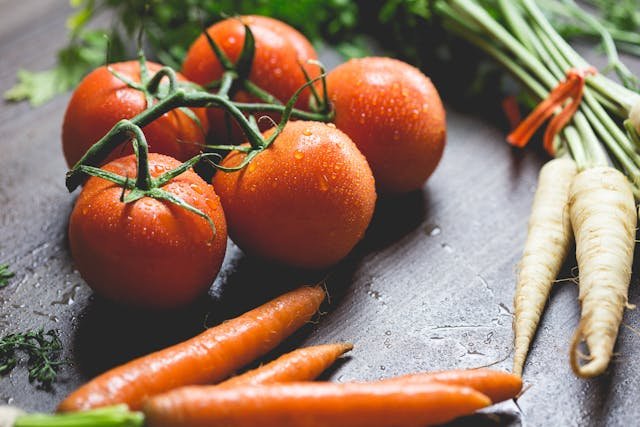Curious about Chinese vegetables? Are you a gardener or just love new languages? This guide is perfect for you. We’ll explore Mandarin produce and its key vocabulary. By the end, you’ll recognize many fresh, tasty vegetables Chinese cooking is famous for.
We’ll also introduce you to LC Chinese School. They provide excellent programs to learn the language. Ready to improve your language skills with Mandarin vegetable vocabulary? Let’s begin!
Table of Contents
ToggleIntroduction to Chinese Vegetables
Let’s start by getting to know Chinese vegetables. In Chinese cuisine, fresh produce plays a big role, adding color and taste. They are also culturally important. These veggies, from leafy greens to unusual gourds, will introduce you to a new culinary universe.
Chinese vegetables are vital in Chinese food and well-loved worldwide. They offer distinct flavors and many health benefits. For anyone interested in food, cooking, or learning languages, discovering Mandarin vegetables is a great step. It will boost your cooking and language skills.
“Chinese vegetables bring both taste and tradition to the plate. By learning about them, you’ll gain a deeper appreciation for Chinese cuisine and its connection to agriculture.”
Every Chinese vegetable has its own story, tied to history and local specialties. From green staples to root veggies, the Mandarin guide shows you how to include Chinese tastes in your dishes.
Knowing Chinese vegetable names helps you shop smarter, try new recipes confidently, and talk about food with Mandarin speakers. Whether cooking a classic stir-fry or a modern dish, learning these words will improve your meals.
Now, we’re ready to explore the vocabulary of Mandarin vegetables. Let’s learn more about these flavorful greens.
Getting Started: Vegetable Vocabulary Basics
Now, you know some Chinese vegetables. It’s time to learn more words. You’ll start with basic vegetable names in Mandarin. These words are the first step to knowing more about various vegetables.
Let’s begin with easy-to-learn names in Mandarin:
- 蔬菜Shūcài – Vegetables
- 青菜Qīngcài – Choy sum
- 花菜Huācaì – Broccoli
- 西红柿Xīhóngshì – Tomatoes
- 姜Jiāng – Ginger
- 黄瓜Huángguā – Cucumber
Don’t forget to practice these words often. It’ll help you remember them better. We’ll keep learning more about Chinese vegetables. Next, we’ll explore even more types of vegetables.
Leafy Greens: Mandarin Vocabulary
Leafy greens are key in Chinese dishes. They bring freshness and color. To truly enjoy them, learn their Mandarin names. Here we list well-known leafy greens and their Mandarin names:
- Lettuce – 生菜 (shēng cài)
- Spinach – 菠菜 (bō cài)
- Bok Choy – 小白菜 (xiǎo bái cài)
- Choy Sum – 菜心 (cài xīn)
- Water Spinach – 空心菜 (kōng xīn cài)
- Chinese Kale – 芥蓝 (jiè lán)
Learning these Mandarin words helps at markets and in recipe talks. It deepens your understanding of Chinese cooking. Keep learning to know more about vegetables and Mandarin.
Root Vegetables: Discover the Chinese Names
Root vegetables play a big role in Chinese cooking. They offer many nutrients and fit in lots of recipes. Let’s learn the Mandarin names for these veggies. This knowledge will spice up your dishes and add variety to your meals.
Carrots
Carrots are a well-loved root vegetable, both nutritious and versatile. In Mandarin, they are known as “hú luo bo” (胡萝卜). They bring a nice crunch and gentle sweetness to stir-fries and salads.
Radishes
With their crunchy bite and sharp taste, radishes are key in Chinese meals. Known as “luó bo” (萝卜) in Mandarin, they shine in different ways. Add them raw to dishes, pickle them for a sharpness, or cook them for a unique flavor.
Turnips
Turnips are another key player, offering a distinct taste in Chinese cuisine. Mandarins call them the same name as radishes, “luó bo” (萝卜). You can stir-fry, boil, or roast them to enjoy their sweet and earthy notes.
Did you know? In Chinese culture, radishes and turnips symbolize good fortune. They’re linked to luck and prosperity.
Now you know the Chinese names for these popular veggies. This will help you better understand Chinese recipes and their diverse flavors. Adding these veggies to your dishes expands your cooking skills. It also deepens your connection with Chinese food and culture.
| Root Vegetable | Mandarin Name |
|---|---|
| Carrots | 胡萝卜 (hú luo bo) |
| Radishes | 萝卜 (luó bo) |
| Turnips | 萝卜 (luó bo) |
Chinese Gourds: Unveiling the Vocabulary
Gourds are a key part of Chinese cooking. They vary in shape and size, bringing different tastes to meals. Knowing their Mandarin names helps fully dive into Chinese dishes. Here’s a look at some common gourds and what they’re called in Mandarin:
Bitter Melon (苦瓜)
Bitter melon, or “ku gua,” is named for its sharp taste and rough, green skin. Despite its unique flavor, it’s a favorite in Chinese cuisine for its health perks. Many dishes, from stir-fries to soups, include bitter melon.
Bottle Gourd (葫芦)
Known as “hu lu,” bottle gourd is shaped like a cylinder and has a light green skin. Its flavor is subtle and it’s full of water, making it ideal for Chinese soups and stews. This gourd works well in both sweet and savory meals.
Sponge Gourd (丝瓜)
Sponge gourd or “si gua” has a soft, absorbent texture. It’s perfect for soups and stir-fries because of its mild taste. In Chinese dishes, it’s valued for its capability to take on the flavors of other foods.
Additional Chinese Gourds
There are more gourds in Chinese cuisine besides those we’ve mentioned:
- Snake Gourd (蛇瓜) – It has a slight sweetness and grows in a curved shape.
- Wax Gourd (冬瓜) – A big, round gourd that’s common in soups and sweets.
- Luffa Gourd (丝瓜) – This fibrous gourd is used in stir-fried and stewed dishes.
- White Gourd (白瓜) – A fresh, crunchy gourd often seen in salads or chilled meals.
Knowing the Mandarin names helps you explore Chinese recipes and share your meal preferences.
| Gourd | Mandarin Name |
|---|---|
| Bitter Melon | 苦瓜 |
| Bottle Gourd | 葫芦 |
| Sponge Gourd | 丝瓜 |
| Snake Gourd | 蛇瓜 |
| Wax Gourd | 冬瓜 |
| Luffa Gourd | 丝瓜 |
| White Gourd | 白瓜 |
Sprouts and Shoots: Master the Chinese Vocabulary
Sprouts and shoots taste great and are full of nutrients. They make your meals more flavorful and healthy. Here, we learn the Mandarin names for these greens. Let’s grow our veggie vocab and dive into the world of Chinese greens.
1. Bean Sprouts
Bean sprouts add a nice crunch in Chinese dishes. In Mandarin, we call them 豆芽 (dòu yá). They’re great in stir-fries, soups, and noodles for a unique texture.
2. Pea Shoots
Pea shoots, or 豆苗 (dòu miáo), are baby pea plant leaves and tendrils. They taste subtly sweet and fresh. Use them in stir-fries or as a side. They bring a lovely green color and crunch to meals.
3. Other Delicious Options
Chinese cooking offers many other sprouts and shoots. Learn the Mandarin names for watercress (西洋菜 – xī yáng cài), alfalfa sprouts (牧草豆芽 – mù cǎo dòu yá), and enoki mushrooms (金针菇 – jīn zhēn gū). Enjoy unique flavors and textures in your meals.
| Vegetable | Mandarin Name |
|---|---|
| Bean Sprouts | 豆芽 (dòu yá) |
| Pea Shoots | 豆苗 (dòu miáo) |
| Watercress | 西洋菜 (xī yáng cài) |
| Alfalfa Sprouts | 牧草豆芽 (mù cǎo dòu yá) |
| Enoki Mushrooms | 金针菇 (jīn zhēn gū) |
Explore Chinese sprouts and shoots by using them in your cooking. Try mixing, seasoning, and cooking these greens in different ways. Now that you know their Mandarin names, discover their freshness and flavor. Let your cooking adventures begin!
Unique Chinese Vegetables: Vocabulary Exploration
Chinese cuisine offers a wide range of unique vegetables. Many newcomers find these Mandarin vegetables unfamiliar. Let’s explore the names of these lesser-known Chinese vegetables. This will help you learn more about Mandarin produce.
Lotus Root
The lotus root is an interesting vegetable in Chinese dishes. It has a delicate taste and looks very unique. In Mandarin, it’s called “he mu.” This vegetable is great for stir-fries, soups, and stews. It adds a nice crunch and sweetness to meals.
Yam Leaves
Yam leaves, or “shan yao ye” in Mandarin, are unique and healthy. They come from the yam plant. These leaves are perfect for Chinese soups and stir-fries. They bring an earthy taste and a beautiful green color to dishes.
Winter Melon
Winter melon, or “dong gua” in Mandarin, is a must-try in Chinese cuisine. It’s used a lot in soups and stews. This large melon has a mild, cool taste. It’s a great addition to summer dishes. The melon absorbs flavors well and complements other foods in a clear broth.
Amaranth Greens
Amaranth greens, or “xiang chun cai” in Mandarin, are beloved in Chinese cooking. They have a delicate, slightly tangy taste. These greens are ideal for stir-fries or soups. They are a nutritious, colorful part of any meal.
Conclusion
Congratulations on learning key Chinese words for vegetables! You now know more about Mandarin veggies. This guide helps you understand the culinary world in China, from leafy greens to special Chinese produce.
To learn more and boost your language skills, consider LC Chinese School. They have great programs for mastering Chinese, including learning more about vegetables. Use these new words when you talk. This will deepen your knowledge of Chinese culture and food.
By learning about Mandarin vegetables, you’ll improve your language skills and enjoy real Chinese dishes. You might try cooking traditional recipes or talking to locals. Your Chinese vegetable vocabulary will help you connect more with the language and culture.
FAQ
Can I learn Chinese vocabulary for vegetables even if I don’t have a garden?
Absolutely! You don’t need a garden to learn about Chinese vegetables. This learning path is for everyone. It expands your language skills and helps you know more about Chinese food.
How can learning Chinese vegetable vocabulary benefit me?
Knowing Chinese vegetable words helps you talk better about food and cooking. It makes understanding Chinese culture easier. When you travel or cook Chinese food, these words make things more enjoyable.
Are there any online resources or apps that can help me learn Chinese vocabulary for vegetables?
Yes, many online tools and apps can teach you vegetable words in Chinese. Popular ones are LC Chinese School, Duolingo, FluentU, and HelloChinese. They offer fun lessons and activities to learn at your own speed.
How do I pronounce the Chinese vegetable words correctly?
Pronouncing Chinese words for vegetables might be hard at first. Listening to native speakers and using apps with audio can help. Remember the four tones in Mandarin; they change the word’s meaning. Practice saying the words to get better.
Is it important to know the names of Chinese vegetables when dining at a Chinese restaurant?
Yes, it can really help in a Chinese restaurant. Sometimes, the menu has dishes with unfamiliar names. Knowing vegetable names lets you order with confidence and try something new.







